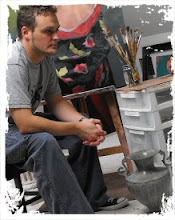 I have learned recently that a great way to see your value progressions and your painting in terms of value, thus removing hue and saturation; is to observe your piece through a red colored glass or acetate film. These are easily purchased through the internet, camera stores, etc. This technique allows you to see your piece as a series of values as it eliminates color from the scenario. While hue and saturation are important in mixing a color, value is a far more important quality to your decision making process. Afterall, value is what the human eye responds to first before hue and saturation.
I have learned recently that a great way to see your value progressions and your painting in terms of value, thus removing hue and saturation; is to observe your piece through a red colored glass or acetate film. These are easily purchased through the internet, camera stores, etc. This technique allows you to see your piece as a series of values as it eliminates color from the scenario. While hue and saturation are important in mixing a color, value is a far more important quality to your decision making process. Afterall, value is what the human eye responds to first before hue and saturation.As seen below, I have illustrated this approach by using my most recent painting "Burlesque Girl" as an example. On the one hand, you will see the painting as it is, in full color and a second option as observed through a red filter.

 Note how the red acetate simplifies the work into value scales and how colors that may appeared different might be much more closely related than initially tought. It is easy to see that while in some instances I believed the color to be working correctly, I may have considered adjusting the values more so to create a richer experience of the work in general. Some forms may have been further rendered including a step here or there to help to describe the form better as it turns in space. Value may also have been adjusted in large areas to create a better separation and compelling composition. Although the girl is obviously the center of attention and the values are generally successful here, had I utilized this approach from the beginning the value shifts might be more subtle and help to describe the form better. The thought here is simple, that while color is important, value is the key to creating realistic, life-like paintings. You may subscribe to this blog by following the link on the right hand side or the page or follow me on twitter at http://twitter.com/wseccombe. Thank you.
Note how the red acetate simplifies the work into value scales and how colors that may appeared different might be much more closely related than initially tought. It is easy to see that while in some instances I believed the color to be working correctly, I may have considered adjusting the values more so to create a richer experience of the work in general. Some forms may have been further rendered including a step here or there to help to describe the form better as it turns in space. Value may also have been adjusted in large areas to create a better separation and compelling composition. Although the girl is obviously the center of attention and the values are generally successful here, had I utilized this approach from the beginning the value shifts might be more subtle and help to describe the form better. The thought here is simple, that while color is important, value is the key to creating realistic, life-like paintings. You may subscribe to this blog by following the link on the right hand side or the page or follow me on twitter at http://twitter.com/wseccombe. Thank you.Billy Seccombe
www.billyseccombe.om
https://twitter.com/wseccombe





There's a problem with using the red acetate- as colors approach green they will be darkened more than colors approaching red, which will appear relatively lighter. This is due to the subtractive nature of looking through a colored transparency.
ReplyDeleteSince I don't use the acetate I'm not sure how drastic the effect is, so it may still be a useful tool..